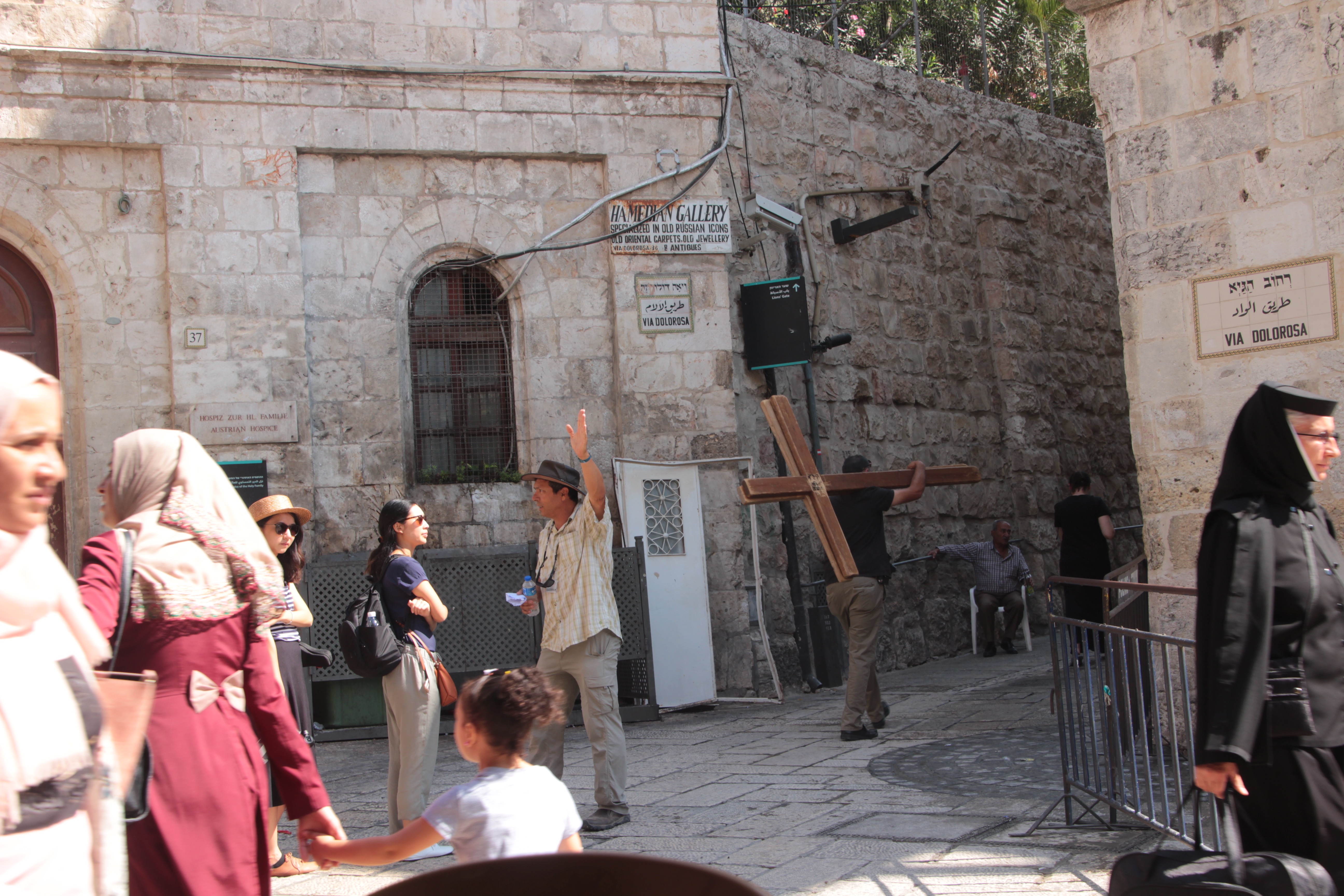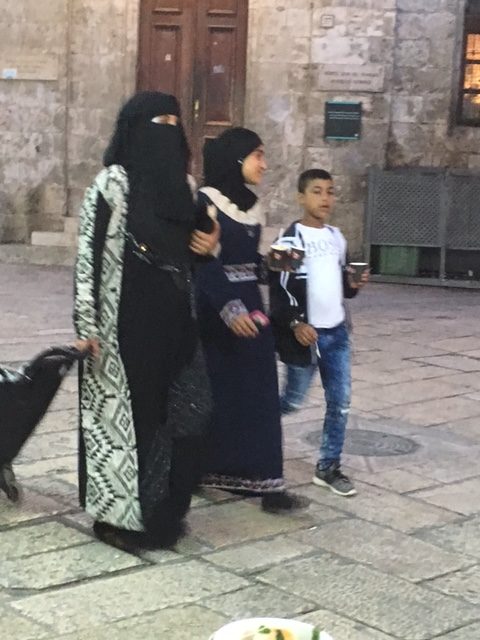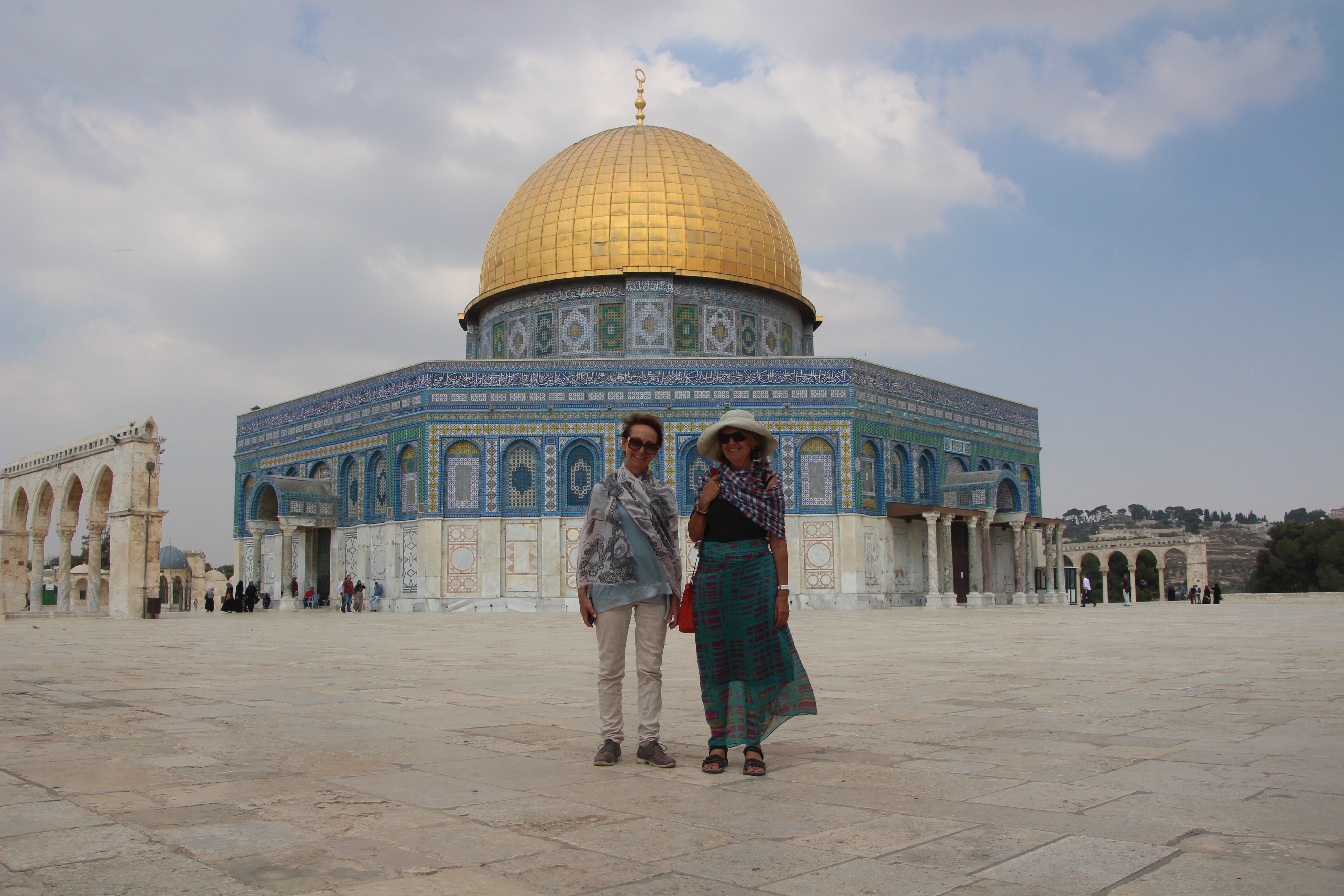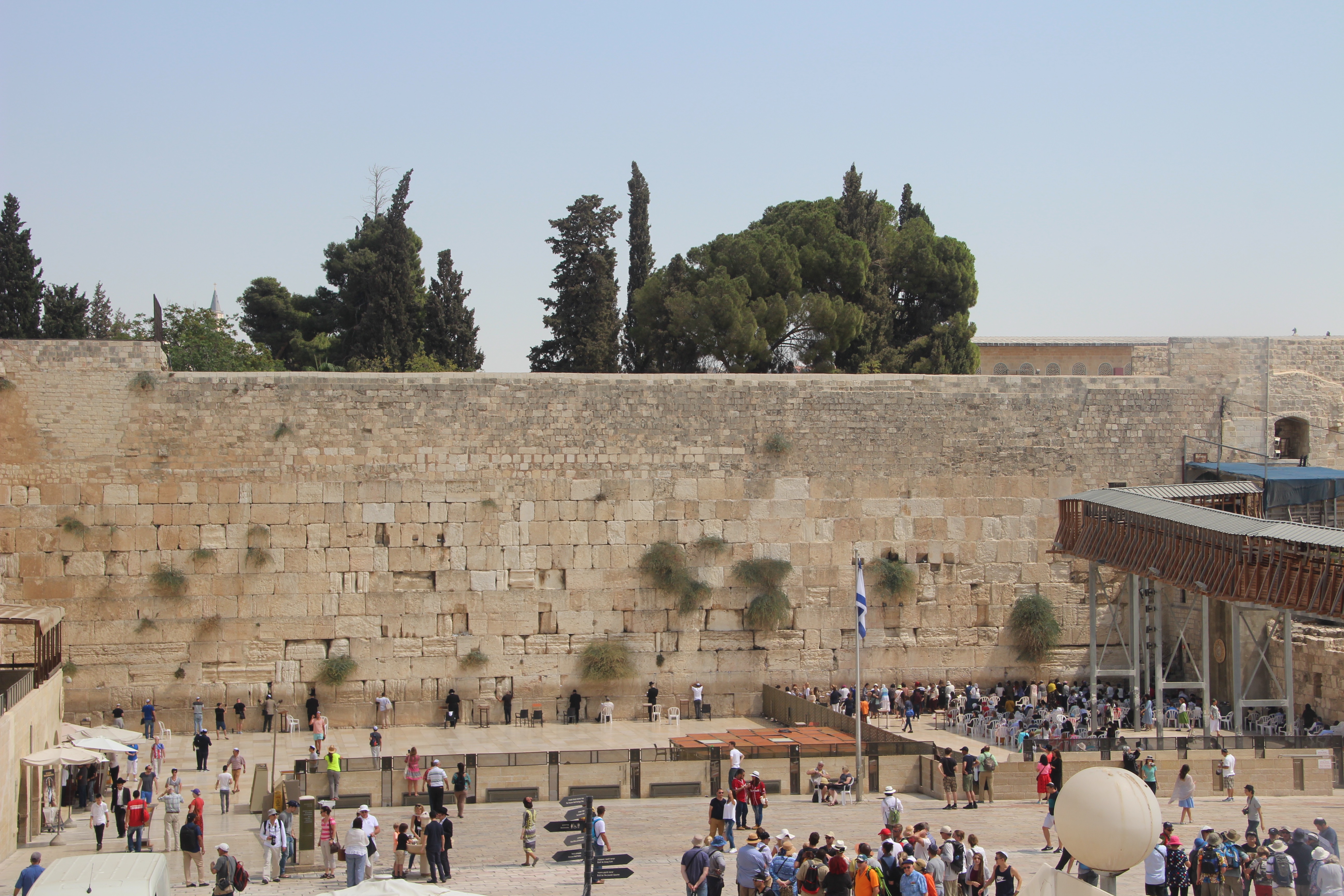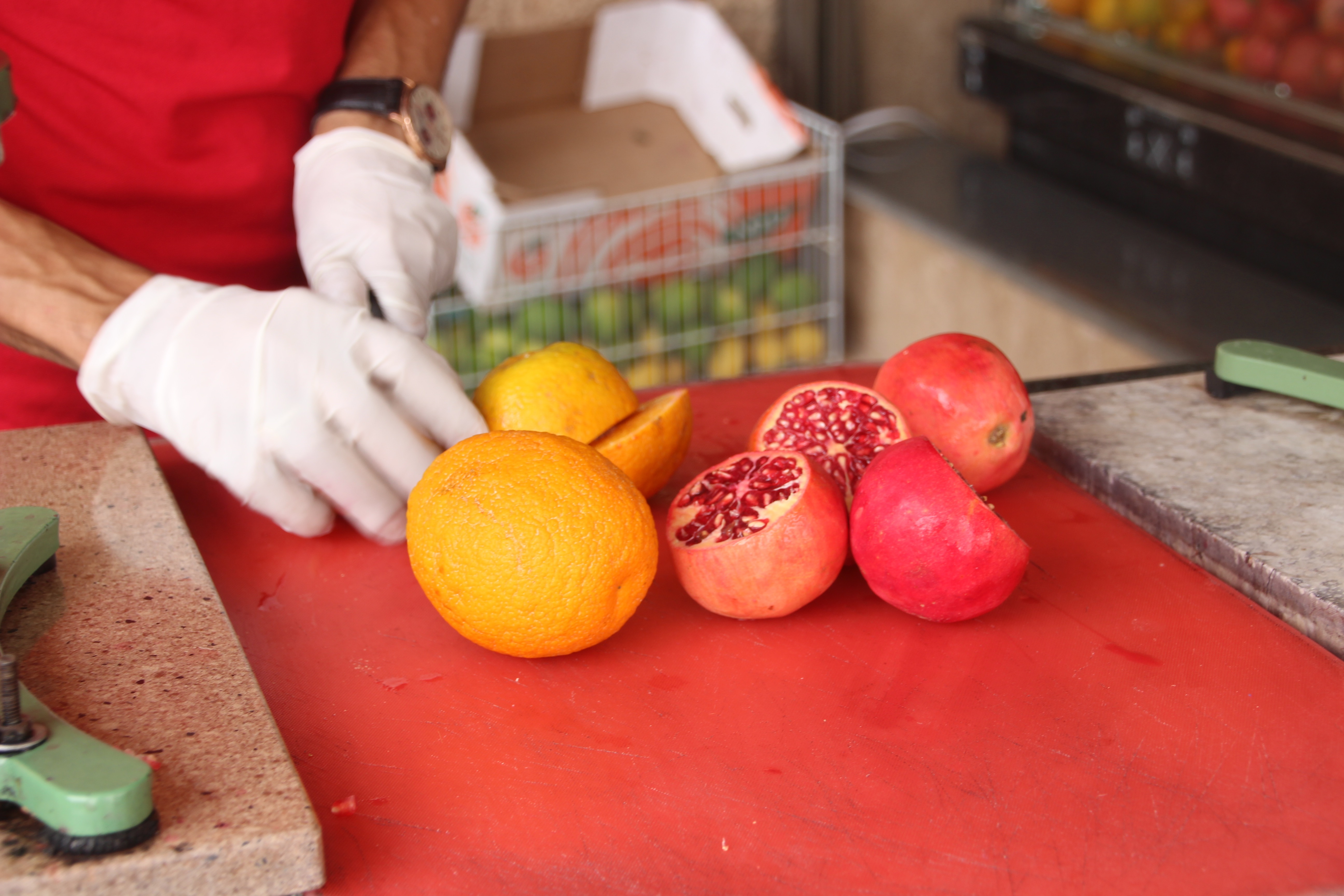It would take less than two hours to drive from Amman to Jerusalem without the stop at the bordercrossing of the King Hussein bridge. I was warned by Lorenz. With aggressive interrogation, he once was kept for six hours at the Israeli border. I was lucky – nobody asked me anything, I just had to wait one hour for my passport to be cleared. Nevertheless, crossing the border is a confusing experience.
I met my sister Christi in the Austrian Hospice, where we stayed for four nights.
The Hospice is located directly at the Via Dolorosa in the Old Town.
Austrian Hospice
The view from the rooftop of the Austrian Hospice is spectacular!
To the left is the 8th century Muslim Dome of the Rock. The place is sacred for Jews, Christians and Muslims. King Solomon built the first Jewish temple over the sacred rock in 960 BC.
Herodes built the second temple, bigger and more luxurious. It is said that the walls were covered with gold. Jesus came to this temple to pray. The Muslims believe that Mohammed ascended to Heaven to meet Allah from the rock. All three religions feel entitled to own this spot.
Our favorite place was a cafe opposite the Hospice, from where we watched the life on the street. Often up to 12 young heavily armed policemen stood at the corner and watched the crossing between Via Dolorosa and Hogai street. One time, a young Palestinian was pulled out of the crowed walking the street and searched with his body turned towards the wall and with his hands up. Nothing could be found.
A Christian believer carrying the cross on the Via Dolorosa, the street where Christ was believed to have carried the cross. We have heard that crosses like that were rented from a Palestinian.
The Hospice is located near the Damascus Gate
I never have experienced a town like Jerusalem. The walled-in city with 8 gates was breathing out history from every corner. Narrow covered streets were filled with smells of herbs, bakery, sweets and incense. The ringing of church bells, the call of the Muezzin and the singing and praying of Christian pilgrims walking on the Via Dolorosa all had space, together with the early morning call of a cock near our window. However, on nearly every corner Israeli soldiers were located, dominating and controlling the town with the power of their weapons. A dangerous calmness filled the streets. I could feel the pinned up emotions of the suppressed population. Often, we talked with locals about a solution to this situation. I came to the conclusion that only a world government giving each group equal rights could solve the problem. Will it ever happen?
We walked a lot. However, this time I hardly took photos. There were too many attention grabbing details, so many interesting sites, people, situations.
One of many Suqs (shopping streets) in the Old Town of Jerusalem. Many Suqs were covered with a vaulted ceiling protecting the people from the sun.
The visitors could only be in the outer vicinity of the Dome of the Rock for a short time. I had to wrap the scarf around my dress in order to hide my lower legs. A kind visitor was lending me his scarf to cover my shoulders.
We stayed in Jerusalem during the time of the Jewish New Year. Many traditionally dressed Jews with fur hats, clothed in white or dressed in a black suit with black hat and two curdles dangling down from the belt rushed to the Western wall to pray and celebrate the New Year. We could only go to the right of the Wall, the place of the women. The left side is reserved for men. It was amazing to see the almost trance like states of Jewish men praying, dancing and singing.
In Jordan as well as in Jerusalem mythological stories as well as religious ones all are connected with a specific place. In Amman, for example, the Roman temple of Hercules is connected to the story of the birth place of Hercules. In Jerusalem, the story of Jesus is always connected to a special place. This goes back to Empress Helena, the mother of the Roman emperor Constantine, who came to Jerusalem at the beginning of the 4th century in search for the most important places of Christianity.
Garden of Gethsemane with 2000 year old olive trees
Church of Holy Sepulchre is the holiest site of Christianity. Over the place where Jesus is thought to be crucified and buried in a tomb, emperor Constantine built the first church. The recent church dates back to the 11th century. Many pilgrims touch the stone slab were Christ’s body is said to have been placed after his crucifixion.
Crosses in the Church of the Holy Sepulchre made by the Crusaders who ruled the city for nearly 200 years (1099 – 1291). It was a gruesome history.
After two full days in Jerusalem, we took a bus to Bethlehem and a taxi to Jericho. On our way to Jericho, we saw many fortified Jewish settlements in the Palestinian areas. 377,000 Jewish settlers live in the occupied area. They isolate the Palestinian towns and force the Palestinians to live in very crowded areas. Palestinians do not get permits to build new houses and if they build, they are bulldozed down. This policy works as a slow depopulation of the Palestinian people. Many Israelis are upset about this behavior too. The Israeli organisation “Breaking the Silence” collects stories told by Israeli soldiers in order to uncover the unjust and gruesome behavior of the Israeli government. For centuries justice was a major topic of the people living in this area. Hopefully, these voices will be heard and peaceful change will occur.
In Jericho, we saw the ruins of the first Western town built 10 000 years ago. High in the cliffs above the town, Jesus is said to have fasted for 40 days. We visited the cave were he fasted and – as the story tells -was tempted by the devil. A monastery is built around this cave like a pigeon loft.
A walkway connecting the different parts of the monastery
We enjoyed fresh orange and pomegranate juice in the cafe Sultan high up on the cliffs.
All the time, strict regulations had to be followed, starting already at breakfast. In the Hospice, a table for breakfast was assigned to us and we could not change it. The breakfast room was in the cellar and very hot and sticky. We wanted to take the breakfast up to the beautiful garden, but it was not allowed. These rules are insignificant ones, but typical for Jerusalem and surroundings. Strict, narrow visiting times, strict rules on how to dress were often enforced. When we wanted to visit the winter palace of Herodes (Herodium) in early afternoon, the Jewish guard told us that the site was closed because of the Jewish New Year. The Palestinian area is divided into three zones, A,B,C, depending who controls the area. The Herodium is under Israeli control.
We visited the birthplace of Jesus in Bethlehem, translated as the House of Bread. Underneath the Church of Nativity, a crypt (cave) is dedicated to the birthplace of Jesus. Many pilgrims kneel down and touch the glass protecting the exact spot where Jesus is said to have been born.
Reported spot where Jesus was born
Now that I have been in Jerusalem and surroundings for a few days and witnessed people of the different religions expressing their faith deeply, committed and convinced that their beliefs are right, it made me think about the word religion itself. In Wikipedia I found that originally, the word derives from RE, meaning “again” and from LIGO meaning “bind, connect”. For me, it is reconnecting with something above right and wrong, something that is integrating all different forces into a unity. It seems to me that this is the only way to real peace in Jerusalem.






